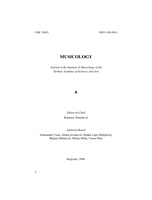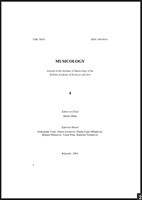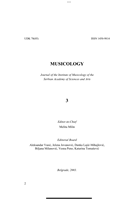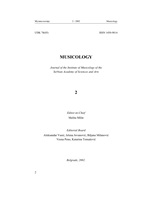Author(s): Borislav Čičovački / Language(s): Serbian
Issue: 4/2004
Opera Zora Dcomposed by Isidore Žebeljan during 2002 and 2003, and which was premiered in Amsterdam in June 2003, is the first Serbian opera that had a world premiere abroad. It is also the first Serbian opera that has been staged outside Serbia since 1935, after being acclaimed at a competition organized by the Genesis Foundation from London. Isidore Žebeljan was commissioned (granted financial backing) to compose a complete opera with a secured stage realization. The Dutch Chamber Opera ((Opera studio Nederland) and the Viennese Chamber Opera (.Wiener Kammeroper) were the coproducers of the first production. The opera was directed by David Pountney, the renowned opera director, while an international team of young singers and celebrated artists assisted the co-production. The opera was played three times in Amsterdam. Winfried Maczewski conducted the Amsterdam Nieuw Ensemble whereas Daniel Hoyem Cavazza conducted the Wiener Kammeroper on twelve performances. The Viennese premier of Zora D. opened the season of celebrations, thus marking the 50th anniversary of the Wiener Kammeroper.The libretto, based on the script for a TV film by Dušan Ristić, was co-written by Isidore Žebeljan, Milica Žebeljan and Borislav Čičovački. Speaking of genre, the libretto represents a melange of thriller, melodrama and mystery, with elements of fiction. The opera consists of the prologue and seven scenes. The story, set in the present-day Belgrade, also goes back to the 1930’s and the periods interweave. The opera was written for four vocalists: the soprano, the baritone, and two mezzo¬sopranos. The chamber orchestra has fifteen musicians.The story: One summer day in 1935, Belgrade poetess Zora Dulijan mysteriously disappears. Sixty years later, Mina, an ordinary girl from Belgrade, quite unexpectedly becomes part of an incredible story, which gradually unravels as time goes by. Led by a dream (recurring night after night, with some vague verses about poplar trees and contours of a mysterious woman with a silver scarf being all that Mina remembers) she sets out to solve the mystery that seems to haunt her for no apparent reason. Part of the secret is also an invisible force, which Mina uses to gradually piece together the story of a great love that was brutally brought to an end 60 years ago and now seeks fulfillment. At the same time, Vida, a woman in her 80s, who has just returned to Belgrade from a long exile, begins to feel tortured and haunted by ghouls from the past, the very7 same she has been trying to escape all those years. Mina, desperate to solve the mystery7, and Vida, in search of final rest and redemption, meet to disclose to us the answer and tell us what really happened to Zora D.The leading characters of the opera, whose main attribute is illusiveness, undergo transformation that is something rarely found in opera literature. This quality of the characters and the story, as well as the absence of a real drama in the libretto, matches the specific idea of a contemporary opera. Unlike composers who insist on giving characters psychological quality, thus reducing their emotions to cliches for reasons of clarity, Isidore Žebeljan demonstrates a need for a completely different type of opera. Her idea is to have an opera which focuses on the sensual exploits of music itself. This is the very type of opera sought after by Isidore Žebeljan. The first and most striking feature of her music is a very unique melodic invention. Opera Zora D. could be described as a necklace of thickly threaded music pearls. Microelements of the traditional music from Serbia (Vojvodina), Romania and the south of the Balkans give her melodies a very special quality7. Those elements, however, have not been taken over in their entirety, nor do they exist in the form that would link this music to any particular type of folk music.Music elements of the traditional music, incorporated in the music expression of Isidora Žebeljan, provide additional distinctiveness and the colour, while being experienced as an integral part of Žebeljan’s creative being which carries within itself the awareness of the composer’s musical roots. Melodic elements of the opera expressed in such a manner give form to vocal parts, which require of performers great musicality and perfect technique without compromising the nature of their vocal expression. Specific chords with a diminished fifth, resulting from the use of folk music scales with augmented second, give the opera a distinct harmonic quality.The rhythmic and metric components of music are complex, naturally stemming from the melody and are characterized by a mixture of rhythms and changeable metrics. The rhythmic patterns of percussion are incorporated in the whole by parallel lining up of melodic and rhythmic layers, so that they produce sonorous multiplicity. Very often the rhythmic elements have characteristics of a dance.The chamber orchestra consists of flute (piccolo and alto), clarinet and bass¬clarinet, saxophon (soprano and alto), bassoon, French horn, trumpet, harp, piano, percussion, and string quintet. By providing specific orchestration and colouring, Isidora Žebeljan manages to completely shift the real dramatic suspense from words to music, particularly the orchestra, thus causing various emotional states to quickly change.Speaking of structure, the opera represents an infinite sequence of melodies. Although rarely, melodic entities have, in some places, the form of arias. There are no real recitatives in the entire opera. Each segment of the opera belongs to a corresponding melodic section of the stage that they are part of.The extraordinary quality of the music in Zora D. lies in the music surprise that it provides, which is an element of the composer’s language and style rarely seen in the music literature but is a symbol of a special talent. Emotional states are not merely evoked through particular musical cliches, the unusual origin of which may be found in the exceptional parallel quality of states stemming from the very music. The listener, in his or her initial encounter with the music of the opera, will never hear dark and disconsolate music when tragic and dramatic happenings are taking place. Listening to the music will, however, help them feel the sound layer of the tragedy that is present in the offered sound. They will not follow it consciously but, instead, they will be leaded to the exact emotional stimulus that they will not be able to defy rationally. Such a music expression we call a music fiction.Artistic team involved in the first production of Zora D. has discovered a HVS technique, which helps shifting elements of scenography, from one set into the next, very efficiently and effectively.Isidora Žebeljan’s opera Zora D. represents a great success of Serbian music on the international scene, and undoubtedly the greatest success of Serbian opera. Her music liberates listeners from the compulsion of reflecting upon the content they are listening to. Instead, her music compels them to feel.
More...




